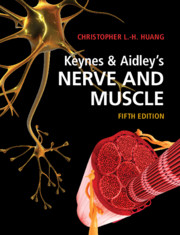Book contents
- Keynes & Aidley’s Nerve and Muscle
- Keynes & Aidley’s Nerve and Muscle
- Copyright page
- Dedication
- Contents
- Preface
- Acknowledgements
- Abbreviations used in the text
- 1 Structural Organisation of the Nervous System
- 2 Resting and Action Potentials
- 3 Background Ionic Homeostasis of Excitable Cells
- 4 Membrane Permeability Changes During Excitation
- 5 Voltage-Gated Ion Channels
- 6 Cable Theory and Saltatory Conduction
- 7 Neuromuscular Transmission
- 8 Synaptic Transmission in the Nervous System
- 9 The Mechanism of Contraction in Skeletal Muscle
- 10 The Activation of Skeletal Muscle
- 11 Excitation–Contraction Coupling in Skeletal Muscle
- 12 Contractile Function in Skeletal Muscle
- 13 Cardiac Muscle
- 14 Ion Channel Function and Cardiac Arrhythmogenesis
- 15 Smooth Muscle
- Further Reading
- References
- Index
9 - The Mechanism of Contraction in Skeletal Muscle
Published online by Cambridge University Press: 07 November 2020
- Keynes & Aidley’s Nerve and Muscle
- Keynes & Aidley’s Nerve and Muscle
- Copyright page
- Dedication
- Contents
- Preface
- Acknowledgements
- Abbreviations used in the text
- 1 Structural Organisation of the Nervous System
- 2 Resting and Action Potentials
- 3 Background Ionic Homeostasis of Excitable Cells
- 4 Membrane Permeability Changes During Excitation
- 5 Voltage-Gated Ion Channels
- 6 Cable Theory and Saltatory Conduction
- 7 Neuromuscular Transmission
- 8 Synaptic Transmission in the Nervous System
- 9 The Mechanism of Contraction in Skeletal Muscle
- 10 The Activation of Skeletal Muscle
- 11 Excitation–Contraction Coupling in Skeletal Muscle
- 12 Contractile Function in Skeletal Muscle
- 13 Cardiac Muscle
- 14 Ion Channel Function and Cardiac Arrhythmogenesis
- 15 Smooth Muscle
- Further Reading
- References
- Index
Summary
Each skeletal muscle fibre comprises a repeating sarcomere structure, each containing interdigitated thin and thick filaments made up respectively of the proteins actin and myosin. Actin is globular protein occurring in a double chain. Myosin consists of globular heads with ATPase activity capable of interacting with actin, connected to fibrous protein components. Activation of the regulatory protein troponin, intercalated within the actin chains, by Ca2+ binding, causes configurational changes displacing the structural protein tropomyosin. This frees binding sites on actin, permitting cycles of cross-bridge formation and dissociation through their interaction with myosin heads, with expenditure of ATP, generating tension. This sliding filament hypothesis was confirmed by examining how peak isometric tension varied with sarcomere length and the consequent actin-myosin overlap determining the potential number of tension-generating crossbridges. The protein titin, amongst others, ensures structural integrity of thick and thin filament arrangement through the resulting cross bridge sliding underlying muscle contraction.
- Type
- Chapter
- Information
- Keynes & Aidley's Nerve and Muscle , pp. 121 - 134Publisher: Cambridge University PressPrint publication year: 2020



